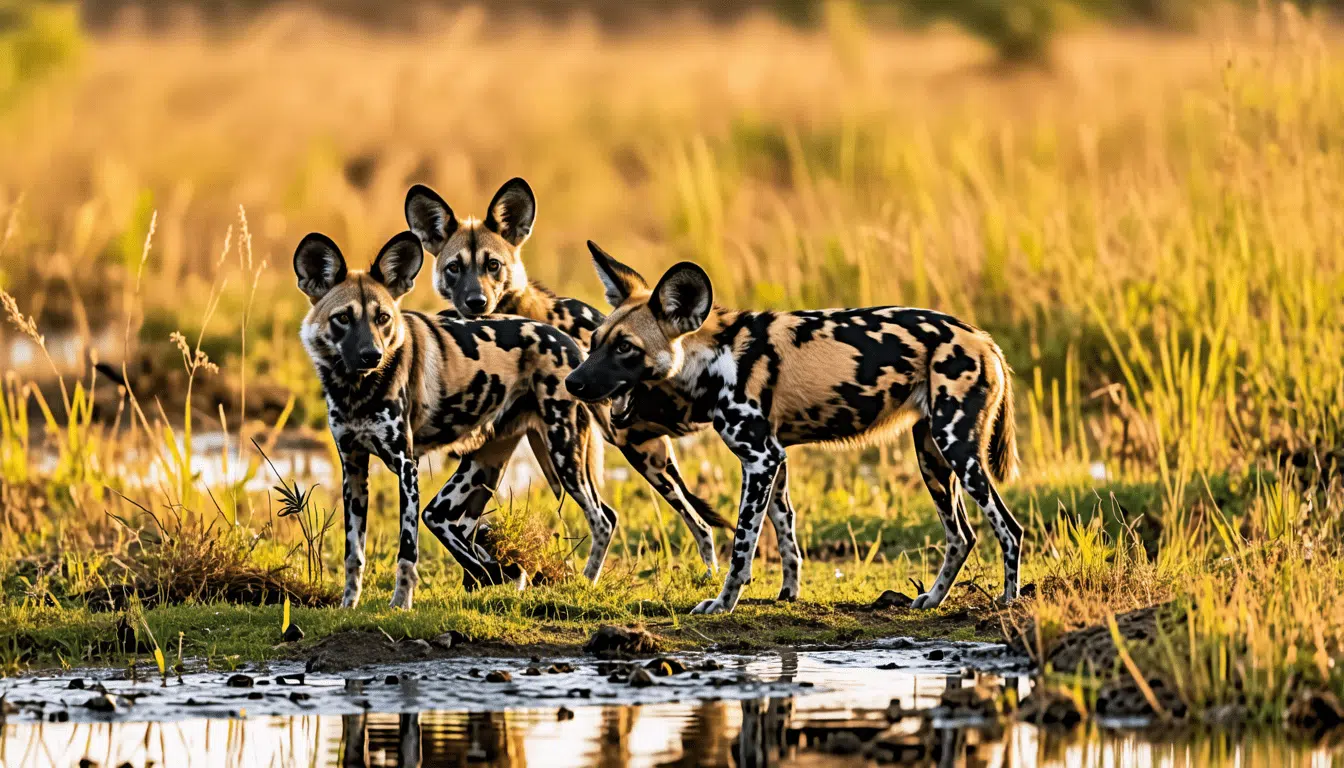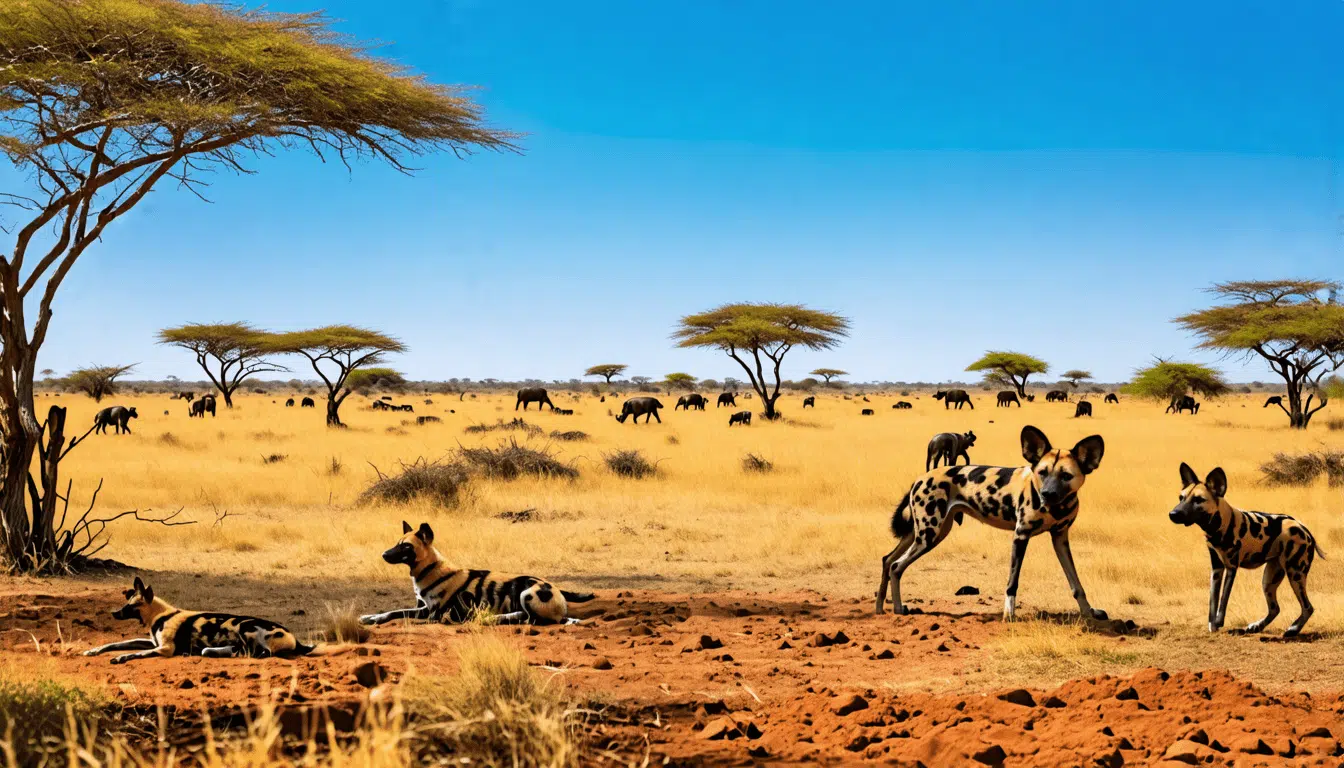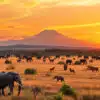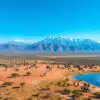Embarking on an African Safari: The Quest for the Painted Wolf
You know, I’ve always had a soft spot for the underdog. There’s something absolutely captivating about those scrappy fighters fighting against the odds. And in the wild kingdom, the African Wild Dog, also known as the Painted Wolf, is just that – a charming underdog with a coat of many colors that’s as mesmerizing as it is unique. Have you ever seen those National Geographic specials where these dogs gallop like choreographed dancers across the savannah? It’s easy to be entranced by their coordinated movements, social structures, and, let’s be honest, just how downright cool they look.
Now, here’s the kicker: these wild dogs are endangered, with a population count that’s sadly more akin to a small town than a sprawling metropolis. With factors like habitat loss and disease whittling their numbers, the chance to see African Wild Dogs in their natural environment is more precious than ever. But why should you hop on a plane and go traipsing through the African wilderness just to catch a glimpse of these creatures? Well, aside from the fact that it’s an unrivaled adventure, witnessing these incredible animals in their natural habitat is a heartening reminder of the beauty and fragility of our world.
The Heart of the Wild Dog’s World
Imagine being in the middle of a vast expanse where every sight is a postcard and every encounter, an untold story. Seeing African Wild Dogs roam freely is more than just ticking off a checklist – it’s about understanding why these environments are pivotal for their survival. Their presence isn’t just crucial for those of us who yearn for that National Geographic moment in real life; it holds immense importance in conserving the delicate ecosystems they inhabit. Every safari offers a peek into their crucial role as hunters and pack animals that maintain the balance within their habitats.
By exploring the best spots to witness these magnificent creatures, you’re not just indulging a thrill-seeking itch – you’re participating in an important conservation narrative, one steeped in hope, adventure, and a bit of wild magic. Remember, it’s not just about where you go, but how you choose to see and engage with these stunning places that make all the difference.
Introduction to the African Wild Dog Safari Experience
Let me take you on a journey to discover one of Africa’s most fascinating and misunderstood creatures—the African Wild Dog, also affectionately known as the Painted Wolf. Now, you might wonder, why would a creature with such an endearing nickname need its own introduction? Well, the Painted Wolf is not just any canid. With its captivating mottled fur, huge round ears that could rival a satellite dish, and a social structure that would make even the most cooperative of human communities envious, the African Wild Dog is a captivating safari highlight worth exploring.
The Unique Characteristics of the African Wild Dog
Imagine a creature that embodies the athleticism of an endurance runner, the strategic prowess of a chess grandmaster, and the social bond of a tightly-knitted family. These dogs travel vast distances, with packs working cohesively to bring down prey. They truly are nature’s team players. What’s even more remarkable is their communication—ever heard a chorus of tweet-like calls? That’s their language! It’s this unique blend of physicality, intelligence, and social behavior that makes observing them in the wild an unforgettable experience. And trust me, once you witness them in action, you’ll gain a newfound respect for these remarkable survivors.
The Endangered Status of the African Wild Dog
Despite their superpowers, African Wild Dogs are on the brink of extinction, with fewer than 7,000 left in the wild. Now, isn’t that a shocker? Habitat fragmentation, human-wildlife conflict, and diseases spread by domestic animals are just a few of the adversities these dogs face. That’s why seeing them in their natural environment isn’t just a treat but an urgent reminder of their plight. Witnessing their raw beauty amidst Africa’s breathtaking landscapes gives us a reason to hope, a reason to care, and, most importantly, a reason to act.
The Importance of Seeing African Wild Dogs in Their Natural Habitat
So, why should you invest your time and resources to see these animals in the wild? It’s not just about ticking off another name on your Big Five list. It’s about experiencing their world, their struggles, and being part of a movement to ensure they continue to roam free. Seeing them in the wild is akin to stepping into an open-air museum where every sighting narrates a tale of survival, adaptation, and beauty. It’s a safari experience that transforms you from a mere spectator to a passionate advocate.
The Crucial Role of Habitats in Wild Dog Conservation
These wild landscapes are their arenas of life. The truth is, without these expansive habitats, African Wild Dogs wouldn’t stand a chance. Each pack needs a territory spanning hundreds of square kilometers. That’s not just a backyard folks; that’s an entire wilderness! These ecosystems are not only their hunting grounds but also breeding and nurturing areas for the next generation of Painted Wolves. They symbolize hope and serve as a living tapestry of conservation efforts aimed at bringing these endangered creatures back from the brink. Witnessing them here offers us insights into why preserving these environments is just as critical as protecting the animals themselves.
As we kickstart our exploration of the African Wild Dog safari experience, let’s embrace the adventure with open hearts and a keen awareness of our role in conservation. Armed with knowledge and empathy, we’re not just tourists or observers; we are part of a larger narrative—a narrative of survival, hope, and a better future for these extraordinary creatures. Are you ready to embark on this journey with me?
Top Destinations to Spot African Wild Dogs
Spotting the elusive African Wild Dogs, also called Painted Wolves, in their natural habitat is like finding a hidden gem in the sprawling African savannas. Sure, lions and elephants get their fair share of attention, but there’s something uniquely captivating about seeing these endangered creatures in action. So, where are you most likely to catch a glimpse of these fascinating packs? Let me walk you through the top five destinations where you stand the best chance of witnessing these amazing canines.
1. Moremi Game Reserve, Botswana
Imagine a place where lush landscapes meet an abundance of wildlife. Welcome to Moremi Game Reserve, nestled in the Okavango Delta, which isn’t just a UNESCO World Heritage site but also a bustling hub of biodiversity. I’ve been there myself, and trust me, it feels like stepping into another world. The reserve’s mosaic of habitats—from floodplains to dense forests—creates the perfect backdrop for African Wild Dogs. Here, the probability of spotting them is quite high, especially during the dry season when water is scarce and the packs come out to hunt. The riveting drama of predator and prey unfolds right before your eyes. Did I mention the sunsets? Breathtaking.
2. Mana Pools National Park, Zimbabwe
Next, let’s travel to Zimbabwe’s Mana Pools National Park, where the African Wild Dogs, much like seasoned actors, are no strangers to being in the spotlight. This park is known for providing excellent photographic opportunities due to its open terrain and stunning riverine landscapes along the Zambezi River. On one of my trips here, I watched a pack stroll gracefully across the floodplains—an unforgettable sight. The dry season—between May and October—is your best bet for encountering these magnificent creatures as they tend to stay near dwindling water sources.
3. Selous Game Reserve, Tanzania
Turn your compass towards Tanzania, where the sprawling Selous Game Reserve beckons. Covering a staggering 50,000 square kilometers, it’s one of the largest faunal reserves in the world. Here, African Wild Dogs roam freely across diverse habitats ranging from swamps to woodlands. During my time in Selous, our guide was like a magician; he could spot movement in the distance before anyone else realized there was even something to see. Given its vast size, these dogs are some of the most challenging to locate—making any encounter feel like a personal victory. But the sense of adventure? Absolutely worth it.
4. Madikwe Game Reserve, South Africa
Nestled along South Africa’s border with Botswana lies Madikwe Game Reserve, a lesser-known yet incredible destination for wildlife enthusiasts. This reserve is particularly notable for its successful wild dog reintroduction program. Now, you might be wondering, “Does that increase my chances of spotting them?” You bet it does! Small and accessible, Madikwe offers intimate safari experiences. On one visit, just as the sun dipped below the horizon, we came upon a pack relaxing after a busy day of chasing impalas. It’s more than just a sight—it’s a feeling that stays with you, long after you’ve left.
5. South Luangwa National Park, Zambia
Last but certainly not least, South Luangwa National Park is affectionately referred to as the wildlife haven of Zambia. This park is renowned not only for its glorious birdlife but also for housing a thriving population of African Wild Dogs. During the dry season, wildlife congregates around the dwindling Luangwa River, creating prime conditions for sightings. My personal favorite aspect of South Luangwa? The walking safaris. Walking alongside trained guides, while attempting to spot these elusive animals, adds an extraordinary dimension to the safari experience. It’s a bit like stepping into a real-life version of a wildlife documentary, where you’re the one waiting for the dogs to make their grand entrance.
So, there you have it, the crème de la crème of African Wild Dog destinations. Each place offers its unique blend of landscapes and wildlife dynamics, and though there’s never a guarantee with nature, visiting these spots significantly ups your chances. Now, isn’t it time to pack your bags and embark on an adventure of a lifetime?
Factors to Consider When Planning a Safari for African Wild Dogs
Seasonal Considerations: When to Go?
Ah, the age-old travel question: when is the best time to catch a glimpse of those elusive African Wild Dogs? Timing, my friend, is everything. From personal experience, imagine making travel plans only to find out that you’ve arrived just as the rains start and the dogs have retreated deeper into the bush. It’s like going to a concert only to realize your favorite band is on hiatus!
Generally, the dry season is your best bet for an African Wild Dog safari. This typically runs from June to October, depending on the region. During these months, the grass is lower, and water is scarce, so animals—wild dogs included—are more likely to gather at waterholes. It’s like their version of meeting for coffee, only with more hunting and less caffeine.
In places like Botswana and Zimbabwe, the dry season coincides with wildlife being concentrated in specific areas, improving your chances of a sighting. However, always double-check the specific location you’re interested in, as seasonal variances do exist.
Choosing the Right Safari Tours and Guides
Once you’ve nailed down the timing, the next step is selecting a safari tour and guide. Let me tell you, this isn’t something you want to leave to chance or the last-minute recommendation on a travel forum. Finding a guide who knows the habits and favorite haunts of African Wild Dogs can make a world of difference.
Opt for safari operators with proven expertise in the areas renowned for wild dog sightings. Reading reviews and asking for recommendations can be invaluable. A few years back, I met a guide in South Africa who could track African Wild Dogs blindfolded—metaphorically, of course—but his sense of their movements was uncanny.
Moreover, look for tours that prioritize eco-friendly practices. Not only will this support conservation efforts—a win-win for you and the dogs—but it also ensures that your presence in their natural habitat is as non-intrusive as possible. Some operators even offer specialized tracking experiences, which can be both an adrenaline rush and a valuable learning opportunity.
The Challenge of Finding African Wild Dogs
Now, here’s the kicker: African Wild Dogs are notoriously elusive. Hence, patience is essential. Unlike lions or elephants that might casually stroll past your vehicle (cue the envy), wild dogs don’t sit still for long. They cover vast distances swiftly, and tracking them requires both skill and, sometimes, a bit of luck.
Consider joining a multi-day safari tour to increase your chances. A single-day excursion might cut it for some animals, but if you’re serious about spotting these charismatic canines, give yourself more than one day. This way, if one day doesn’t pan out, you have plenty of time to try again.
And for those tech-savvy travelers out there—invest in some good binoculars and a decent camera with a zoom lens. It might not help you find the dogs, but once you do, you’ll want more than just a phone camera to capture their dashingly colorful coats and playful antics.
It’s important to go into your safari with realistic expectations. Despite all your planning, nature doesn’t always cooperate, and sightings aren’t guaranteed. So, while the African Wild Dogs are the main star, appreciate the plethora of other wildlife and landscapes Africa offers. Who knows, you might leave with a newfound love for giraffes, kudu, or even termites!
In summary, timing your trip correctly, picking the right guide, and preparing for the search are key considerations for a successful African Wild Dog safari. While finding the dogs can be challenging, the reward is a moving and unforgettable experience in the wild. You’ll leave with not just photos but an understanding and appreciation of one of Africa’s most enigmatic species.
Conservation Efforts and Responsible Tourism
When it comes to African Wild Dogs, conservation isn’t just a buzzword—it’s a lifeline. These incredible creatures, with their strikingly patterned coats and deeply social behavior, are facing significant threats from habitat loss, human-wildlife conflict, and disease. Did you know that fewer than 7,000 of these animals remain in the wild? That’s a shocking number when you consider the vast landscape of Africa. But don’t despair—there are dedicated conservation initiatives working tirelessly to protect them.
Conservation Initiatives: More Than Just Numbers
One of the standout organizations is the African Wildlife Foundation. These folks are on the ground, working to secure and restore key habitats for the African Wild Dogs. By collaborating with local communities, they’re not only providing safe havens for these canines but also fostering a culture of coexistence. The Painted Dog Conservation, based in Zimbabwe, is another stalwart in this fight. Their anti-poaching units and community outreach programs have contributed to stabilizing wild dog numbers.
Have you ever been on a safari and wondered about the unseen efforts that go into protecting the wildlife you’re so excited to witness? Behind those enchanting sightings are ongoing research projects and monitoring programs. These initiatives track pack movements, study their behaviors, and understand the dynamics of their populations to inform better conservation strategies.
The Role of Responsible Tourism in Conservation
Now, let’s talk about you, the tourist. Yes, you have a crucial role to play in this inspiring conservation story. How? By embracing eco-friendly and sustainable tourism practices, you become an ally in the quest to save African Wild Dogs. Think about it: choosing safari companies committed to conservation means you’re directly supporting local economies and conservation efforts.
When was the last time you joined a guided tour that educated you on the importance of preserving the environment? Many ethical safari operators are now leading the way by incorporating educational components into their tours. They provide insights into the challenges faced by the African Wild Dogs and showcase how conservation efforts are making a difference.
Practical Ways Tourists Can Contribute
Want to do more than just snap photos and return home? There are several tangible steps you can take to contribute to African Wild Dog conservation during your safari adventure. Firstly, consider donating to conservation funds that directly support these animals. Many lodges and camps have partnerships with local projects, making it easy for you to contribute to the cause.
Additionally, supporting local artisans and businesses can indirectly impact conservation efforts. Earnings from these sales often fund community projects that promote sustainable practices and reduce human-wildlife conflicts. Imagine returning home with a handcrafted souvenir, knowing that your purchase helped enhance livelihoods and promote conservation.
And let’s not forget the power of awareness. Share your experiences on social media, talk about the fascinating facts you learned, and raise awareness about the plight of the African Wild Dog. By educating others, you’re expanding the circle of people who care and act.
Finally, one of the easiest and often overlooked ways to help is by following park rules and guidelines during your safari. By respecting wildlife and habitats, you ensure that these delicate ecosystems remain undisturbed, allowing the natural behavior of the African Wild Dogs to continue undeterred. Remember, every little action counts.
So, when you embark on your African Wild Dog safari, remember—you’re not just seeking a thrilling encounter with nature; you’re part of a larger conversation about conservation. By championing sustainable and responsible tourism, you’re helping to secure a future for these magnificent creatures. And isn’t that something to wag your tail about?
While we’ve journeyed through the enthralling landscapes of Africa in search of the enigmatic African Wild Dog, it’s clear that witnessing these creatures in their natural habitat is an experience like no other. Imagine the thrill of spotting this endangered Painted Wolf on the prowl—it’s a moment that stays etched in your memory forever. Each of the top safari destinations we’ve explored offers a unique window into the world of these wild canines, from the sprawling plains of Botswana to the picturesque reserves of Zimbabwe.
These places aren’t just about the sightseeing; they are the heartbeat of crucial conservation efforts that aim to pull the African Wild Dog back from the brink of extinction. Did you know that there are only about 6,000 of them left in the wild? It’s incredible to think how vulnerable they are, and yet how tenacious their spirit is. Visiting these destinations allows travelers like us to contribute to their ongoing survival, all while soaking up the beauty and diversity of the African wilderness.
When planning for a safari centered around these magnificent dogs, timing is everything. A bit like the surfers waiting for the perfect wave, seasoned travelers know that the best sightings come with the right season. Working with knowledgeable guides can also transform your trip from a simple vacation into an unforgettable adventure, as they lead you off the beaten path to where the wild dogs roam. You might face some challenges in the hunt for sightings, but isn’t that part of the thrill?
And beyond the exhilarating chase for the perfect photograph or that fantastic story to tell back home, there’s a deeper connection we forge with nature. Engaging with conservation efforts—whether it’s supporting eco-friendly lodges or participating in community-driven wildlife projects—enables us to contribute meaningfully to the protection of this exquisite species. Who knew that a safari could be an act of service as much as it is an adventure?
In closing, immersing ourselves in the African Wild Dog’s world provides a glimpse into the intricate tapestry of life that thrives in Africa’s wilderness. It’s a dance of survival and wonder, one that reminds us of the beauty and fragility of nature. So, why not go beyond just being a tourist and become an advocate for these incredible animals? After all, witnessing these painted wolves in the wild means stepping into a story that’s bigger than ourselves—a story that we have the power to help rewrite for future generations.






